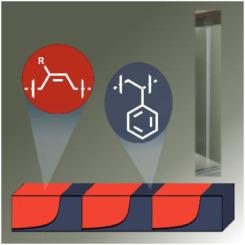Progress in Polymer Science ( IF 26.0 ) Pub Date : 2021-12-03 , DOI: 10.1016/j.progpolymsci.2021.101488 Marvin Steube 1 , Tobias Johann 1 , Ramona D. Barent 1 , Axel H.E. Müller 1 , Holger Frey 1

|
Thermoplastic elastomers (TPEs) combine the features of vulcanized thermoset rubbers and thermoplastic materials in their phase-separated microdomain structure. As a consequence soft, flexible and resilient materials are obtained, which can be high-speed processed from the melt state. In the last decades, a variety of polymerization strategies has been proven successful to synthesize block copolymers for TPE materials on an industrial scale. Motivated by the outstanding properties of natural rubber (cis-1,4-polyisoprene), the alkyllithium initiated anionic polymerization of isoprene and butadiene plays a key role for the flexible block of TPEs. The synthesis of ABA-type triblock copolymers based on styrene and 1,3-dienes leads to phase-segregated systems which do not require chemical crosslinking. The living character of the carbanionic chain end was utilized in numerous studies to synthesize complex, defined comonomer sequences by multi-step synthesis. Systematic variation of numerous parameters, e.g. block size and sequence allowed to correlate the resulting mechanical and morphological properties with polymer structure. In this review the focus is placed on multiblock structures and gradient copolymers, addressing key parameters of the molecular architecture to enable a general concept for the design of TPE materials with tailor-made properties. The choice of monomers, also bio-based diene structures such as β-myrcene or β-farnesene is another parameter. The major focus is put on the direct, i.e. statistical anionic copolymerization kinetics as the method of choice to synthesize rather complex multiblock sequences in a one-pot reaction. On-line spectroscopic methods are presented that enable to monitor the monomer consumption during the copolymerization, which directly translates to the comonomer incorporation and gradient formation. To enable precise insight into the comonomer composition of the formed chains, an overview of the theory of copolymerization and the determination of reactivity ratios is given. Kinetic Monte Carlo simulation (kMC) is a versatile tool. Based on experimentally determined kinetic rate constants, the copolymerization can be performed in silico. This enables access to relevant parameters, as for example the conversion as a function of the time as well as the the composition and monomer sequence in individual chains, which allow rational design and evaluation of synthetic experiments.
中文翻译:

热塑性弹性体锥形多嵌段共聚物的合理设计
热塑性弹性体 (TPE) 在其相分离的微域结构中结合了硫化热固性橡胶和热塑性材料的特性。结果是获得柔软、柔韧和有弹性的材料,可以从熔融状态高速加工。在过去的几十年中,各种聚合策略已被证明可以成功地以工业规模合成用于 TPE 材料的嵌段共聚物。受到天然橡胶(顺式-1,4-聚异戊二烯),烷基锂引发的异戊二烯和丁二烯的阴离子聚合对于 TPE 的柔性嵌段起着关键作用。基于苯乙烯和 1,3-二烯的 ABA 型三嵌段共聚物的合成导致不需要化学交联的相分离系统。碳负离子链末端的活性特征被用于通过多步合成合成复杂的、确定的共聚单体序列的众多研究中。许多参数的系统变化,例如嵌段大小和序列,允许将所得机械和形态特性与聚合物结构相关联。在这篇综述中,重点放在多嵌段结构和梯度共聚物上,解决分子结构的关键参数,以实现具有定制特性的 TPE 材料设计的一般概念。单体的选择,以及生物基二烯结构如 β-月桂烯或 β-法呢烯是另一个参数。主要关注点放在直接的,即统计阴离子共聚动力学上,作为在一锅反应中合成相当复杂的多嵌段序列的首选方法。在线光谱方法能够监测共聚过程中的单体消耗,这直接转化为共聚单体的掺入和梯度形成。为了能够精确了解所形成链的共聚单体组成,给出了共聚理论的概述和反应性比率的确定。动力学蒙特卡罗模拟 (kMC) 是一种多功能工具。根据实验确定的动力学速率常数,可以进行共聚电脑模拟。这使得能够访问相关参数,例如作为时间函数的转化以及单个链中的组成和单体序列,从而允许对合成实验进行合理设计和评估。











































 京公网安备 11010802027423号
京公网安备 11010802027423号